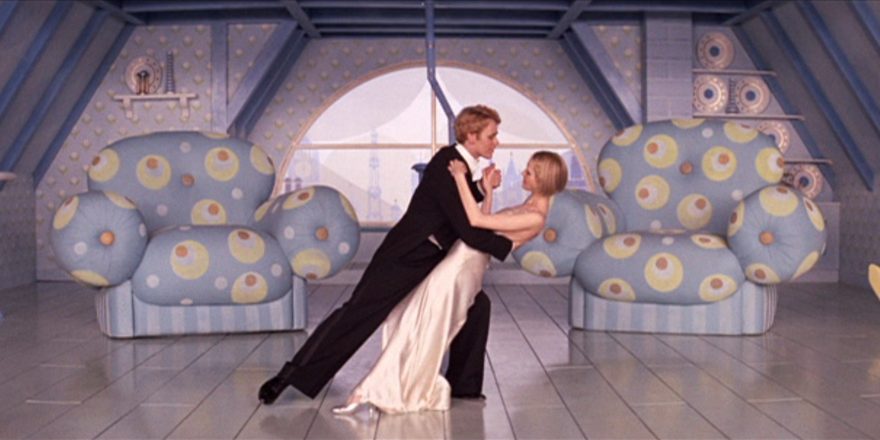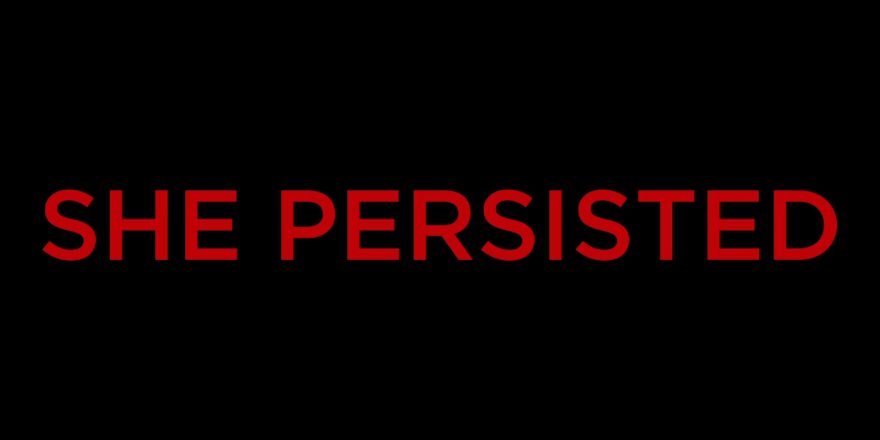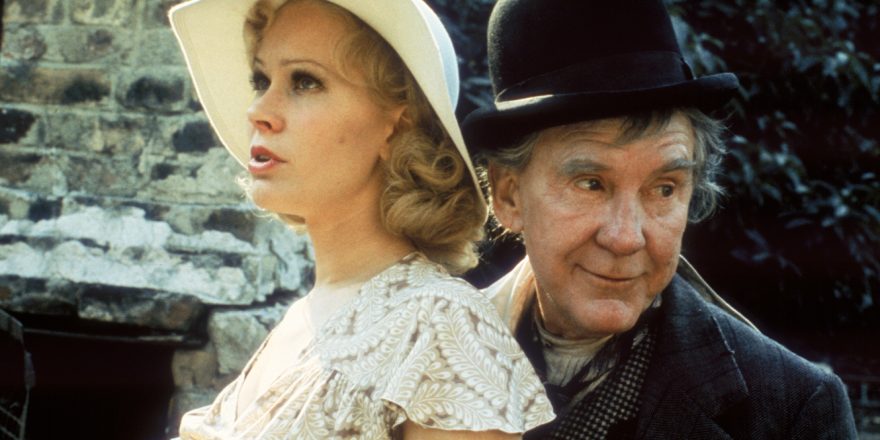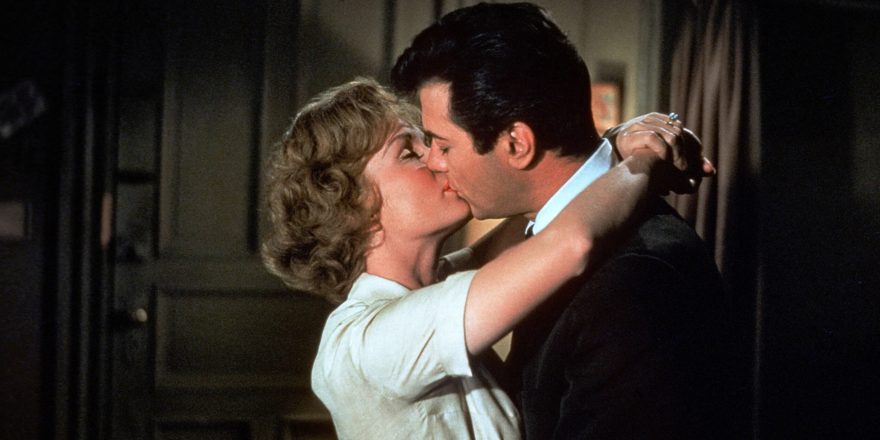“Reality is a dirty word for me, I know it isn’t for most people, but I am not interested. There’s too much of it about.” – Ken Russell
The 1970s were my formative years of moviegoing and creative awakening. When I urgently wanted to see Ken Russell’s The Boy Friend, it wasn’t because it was a G-rated musical, but because I knew it was directed by the man who’d made Women in Love, The Music Lovers and The Devils. I knew this from studying the Sunday New York Times Arts & Leisure section, and reading everyone from Pauline Kael to Rex Reed, and Playboy’s annual “Sex in the Cinema” issue. I was 12.
I first saw The Boy Friend – or rather the first 30 minutes or so of the film – in April 1972. It was playing too far away for me to wander off to the local theater to see it on my own, so I pestered my mother to take me to see it. I have this vivid sense memory of sitting there in a mostly empty theater alongside my mother and my brother Peter, with palpable annoyance and impatience rising from my left and right, while this strange wide-eyed creature, Twiggy, warbled a song perched upon a swing adorned with flowers. The orchestration was small; her voice alien; and nothing felt at all like a musical anyone would want to see, or had ever seen. We bailed, and it being a “twin” theater, walked across the hall to catch the rest of What’s Up, Doc?, which Peter and I had seen twice already. My mother was just relieved to be anywhere else. I look back fondly on this for many reasons, not least because it was the first time I ever snuck into a movie without paying.
Ken Russell’s feature films of the ’70s, and into the ’80s, are bold, subversive spectacular cinema. He first gained notoriety in the late 1960s with a series of film biographies for the BBC about composers and artists, which shattered the stuffy conventional style that was previously embalming the minds of viewers. He became a “name” director with his intoxicatingly ripe big-screen adaptation of D. H. Lawrence’s Women in Love (released in the U.S. in 1970) that won Glenda Jackson the first of her Best Actress Oscars, and featured a groundbreaking homoerotic full-frontal nude wrestling scene before a roaring fire between Alan Bates and Oliver Reed. (This I caught up with when I was 14.)
After D.H. Lawrence, Russell would consistently return throughout the ‘70s to real-life creative figures – mainly artists and composers – to make what I describe as historical (and hysterical) fantasia. His films have the mad crackling urgency of genius revolting against convention, while increasingly retreating wholly into an artificial world, akin to Fellini’s output after Juliet of the Spirits. With a seismic run from 1970 to 1977 – The Music Lovers through Valentino – Russell’s films are anarchic interpretations of biography and history born of his reaction to music, art, politics, religion and pop culture. Russell littered his work with deliberate anachronism, vulgar poetic energy, breathtaking design and perverse humor, and unlike color-era Fellini, gave his actors the freedom to rise to the surroundings, rather than being ornamental. Russell riled many, repulsed others, and thrilled most of us for these very reasons (and more.) He clearly didn’t give a damn either way.
His disdain for purists is partly what I suspect was at the core of initial rejection of The Boy Friend, a film all these years later, I now consider to be not only one of Russell’s best, but also one of the great movie musicals from after the Classic Hollywood era.
Some background: The Boy Friend originated on stage with Julie Andrews in the starring role of Polly Browne, first in London in 1953 and then on Broadway, where Andrews made her American debut. The show itself, with book, music and lyrics by Sandy Wilson, is a clever pastiche of 1920s musicals with a gossamer plot. MGM planned to make a film version in 1956, but with the studio facing economic woes, it was cancelled. Film producer Ross Hunter attempted to acquire the rights from the studio in the mid ’60s for Andrews, now a major screen star. The asking price was too high, so he turned around in 1967 and created his own alternate 1920s flapper pastiche movie musical for Andrews, Thoroughly Modern Millie, directed by George Roy Hill.
Flash-forward to 1971, Ken Russell is meeting with the iconic Swinging ’60s model Twiggy to discuss a possible film project, a “fairy story” with music by Paul McCartney. Russell had just wrapped production on his brutal and controversial masterpiece The Devils, which, even before its premiere, had gained notoriety with rumors that there were real orgies involving nuns on the set. According to Russell’s autobiography, he and Twiggy, deep in drunken conversation, were extolling their admiration for everything from The Beatles’ Sgt. Pepper to Sandy Wilson. They were interrupted by an intruding reporter who, after prodding Russell about lascivious nuns, asked him what his next project was. He jokingly answered The Boy Friend starring Twiggy, which, after The Devils, was the last thing anyone would have imagined. An item ran the next day in a showbiz column, and lawyers from MGM rang immediately to make Russell aware that they, not him, owned the rights.
By the dawn of the 1970s, the movie musical was a waning genre at the box office, and most of the great Broadway musicals had, to varying degrees of success (and failure), been mined for the screen. The studio was eager to make The Boy Friend happen, seeing the property as dormant and stale, and glad that anyone would have interest. Russell’s joke, an inebriated lark, was greenlit. Never mind that Twiggy had never acted, let alone sung or danced on screen before. Russell said to the studio heads about Twiggy, “Give me three months and I’ll have her dancing like Ginger Rogers and singing like Judy Garland.” Pure hubris. And, of course, her performance wasn’t comparable, though that’s not an insult.
When Twiggy dances, she’s a deco figurine in flight. When she sings, it’s as if she has a gramophone embedded in her throat. She has a voice made for 78s. Her hummingbird vibrato and occasional sharp tones feel authentic to the film’s conceit, which in Russell’s hands, is no longer a straightforward adaptation of the beloved musical, but a deconstruction and highly entertaining meditation on performers, theatre, and movie musicals.
If his other films are historical fantasia – or, in the cases of Tommy and Valentino, pop-culture fantasia – then the experience of The Boy Friend is about being high on movie-musical iconography; dream-factory fantasia in the highest form. In underlying moments, it reminds me of Terence Davies’ The Long Day Closes, where the movies in all their primal flickering beauty represent escape from a lonelier existence. Where Davies finds melancholic pop poetry in Debbie Reynolds singing “Tammy” in Tammy and the Bachelor, Russell, in his own mad way, finds grace, and salvation, in the excess of movie musicals.
Russell’s brilliant construct is to set the film in a rundown theater in Portsmouth, England, where a troupe of actors is presenting a production of The Boy Friend. The film plays as much off-stage as it does on. Russell is faithful, perhaps to a fault, to the original score, and even augments it with two songs best known from Donen and Kelly’s Singin’ in the Rain: “You are My Lucky Star” and “All I Do is Dream of You.” Each is given wistful and intimate solo renditions backstage by Twiggy, different from the imprints left from that classic MGM musical.
Twiggy plays the assistant stage manager who finds herself having to go on as Polly Browne when the star of the show, Rita, breaks her ankle. To add another layer, a famous Hollywood director, E.P. De Thrill, arrives to see the performance where he sits perched in the royal box. Who knows what he’s doing in Portsmouth, let alone seeing the show, but why question it? Time is mischief: a 1953 stage musical about the 1920s as performed by actors in the 1930s in a 1971 film that references movie musicals into the 1950s. Imposing reality would be antithetical to experiencing Ken Russell, let alone movie musicals.
Despite the overall dream-factory logic, the film doesn’t open with some razzle-dazzle number, but simply on a close-up of Twiggy’s headlight-beamed eyes, her face freckled, holding a baby (not hers) while dreamily gazing upon a photo of the male ingénue (played by Christopher Gable.) Russell wittily introduces the actors in a succession of keenly observed backstage vignettes. (In the communal ladies dressing room, a message written in lipstick on the absent star’s makeup mirror: “Rita: Call your sailor.”)
The performances from the film’s ensemble cast are pitch-perfect, with just the right balance of self-knowing wink and genuine conviction. The chorus dancing, with the skilled exception of Tommy Tune (whose character grew up in vaudeville), is decidedly Joan Crawford and Ruby Keeler; the women’s bodies fleshy and rounded; the men pale and thin. Glenda Jackson shows up in a delicious unbilled cameo as Rita, hobbling on crutches. When we see her sitting in the audience crying glycerine tears while Twiggy/Polly cries on-stage for real, Russell contrasts illusion even in the small moments. It’s at once hilarious and moving.
The on-stage musical numbers are mostly shot in static proscenium wide and medium frames, as if viewed from a seat in the theater, but as seen from De Thrill’s (Russell’s) point of view they open up into lavish and often outrageous production numbers, and then further, as imagined within the actors’ minds. Russell references everything from Busby Berkeley to Fred and Ginger, yet with its subversive distillation of nostalgia and camp, the film feels more in line with the radical theater group the Cockettes, born out of San Francisco hippie culture, the Theatre of the Ridiculous movement that emerged in New York in the mid ’60s, and The Carol Burnett Show, rather than with traditional movie musicals adapted from Broadway. The production design by Tony Walton and costume design by Shirley Russell is wondrous; from the massive production numbers to witty allusions (Twiggy as a silver hood ornament on a Rolls Royce). Everything is a deliberately too small or big for the “normal” action on stage, with scenery its own comic motif. Walton described it as “grunge deco.”
The elaborate musical numbers are delirious and breathtaking, especially “I Could Be Happy With You,” in which Twiggy and Christopher Gable dance across the black lacquer grooves of a giant rotating turntable; “A Room in Bloomsbury,” a number that builds into what can only be described as Hollywood filtered through LSD culture set in Pixieland, including giant red mushrooms and a grey-goateed Tommy Tune in a striped bodysuit and tall blue Dr. Seuss-looking hat (adding at least another foot to his 6’6” frame,) and a nod to the “Triplets” number in Vincente Minnelli’s The Band Wagon; and the breathtaking “Poor Little Pierrette,” in which Walton and cinematographer David Watkin create Erté in motion.
Russell also does tricky things with the audio mix. (He produced the soundtrack.) The big fantasy numbers are fully orchestrated, evoking ’30s Hollywood, while the musical numbers and dialogue when played out on stage are devoid of gloss. (“Piano and drums. What must De Thrill think?!”) You hear the creaking of wood stage boards and scenery, and feet hoofing in dance. The piano player, banging on the slightly out of tune keys on the upright, has perpetual ash dangling from a cigarette perched between his half-grinning lips. There’s a startling moment when Antonia Ellis (as Maisie) lands — bam — on top of the piano at the climax of “Won’t You Charleston With Me?” number, and the thump-thump of her shoes and athletic ham-bone thrusts are gaspingly lewd and funny.
This exposed underbelly of show-business foreshadows what Bob Fosse would do so thrillingly in Cabaret (released just a couple of months after the premiere of The Boy Friend.) Showing its seams is what makes Russell’s film, for all of its bravura show-off excess, also so unexpectedly poignant. And because the film’s actors are great at being second-rate, you believe they’d be stuck in this production. (It evokes the character of Sally Bowles in Cabaret, though in Fosse’s film, it’s the selfish desperation in Liza Minnelli’s performance that makes you believe she’d be stuck in the Kit Kat Club. Her electrifying talent isn’t enough.) In The Boy Friend, other than in fantasy, all the performers in this troupe exist either in a state of delusion or longing; they feel an urgent need to flee their dingy theater life and this tacky silly production, with dreams of Hollywood or West End success, but ultimately are faced with their own average and charming limitations. With the exception of one character’s fate, it’s only inside the theater, and in their heads, that they find escape.
Russell’s approach, which seemed so off-putting to movie musical audiences in 1971, now feels strikingly modern and influential. There is much here that points ahead not only to Fosse’s brilliant lacerating work as a film director, but also to Dennis Potter, especially Herbert Ross’ thrilling 1981 film version of Pennies From Heaven, Peter Bogdanovich’s At Long Last Love, Woody Allen’s Everyone Says I Love You, François Ozon’s 8 Women, and the lesser descendant Broadway-to-film versions of Chicago and Nine.
When first released in the U.S., the studio cut The Boy Friend by over 25 minutes, losing production numbers including much of “A Room in Bloomsbury” and “Polly’s Dream,” a jaw-dropping pastoral-turned-bacchanal musical sequence. (The film has now been restored to its full 137 minutes on home video.) It’s debatable whether these cuts were reason for its initial failure, but certainly a film that is so carefully calibrated and constructed in its rhythm can’t help but be damaged by indiscriminate cuts.
The expectations for The Boy Friend were traditional; audiences coming off a decade of lavish roadshow musicals expected aural polish, with pure voices and big orchestrations. But people weren’t flocking to see musicals anymore, and The Boy Friend as a “brand event” wasn’t Fiddler on the Roof (released a month earlier) nor was Twiggy a reigning movie musical star like Barbra Streisand (or Julie Andrews, for that matter).
What Russell served up was avant-garde marketed as a toe-tapping family musical dipped in nostalgia. I intuitively felt its daring and gall somehow when I was 12. And that image of Twiggy on the swing; it lingers.








